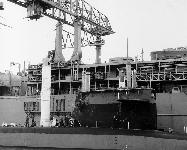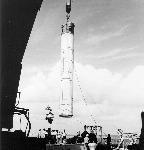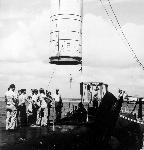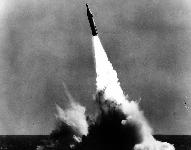









The Polaris A2 had a 1,500 mile range, weighed 32,500 pounds and was 31 feet long. It was the same diameter as the Polaris A1 -- four-and-a-half feet--and could be launched from the same tubes inside a submarine. The first A2 travelled more than 1,400 miles from Cape Canaveral, Florida, when it was launched on November 10, 1960. It became operational on June 26, 1962, with the initial deployment of the Ethan Allen, the first submarine of its class designed from the keel up as an SSBN, a nuclear-powered, ballistic missile submarine.
SPO on 28 November 1958 directed initiation of the second-generation missile, POLARIS A2 (1500 nm), to be loaded on the sixth SSBN in October 1961. The Polaris A2 was dimensionally quite similar to Polaris A1 except the first stage was 30 in. longer. With a total weight 32,500 Ib and a length of 31 ft; the A-2 had a range approximately 1450 nm. The first stage (22,400 lb) used a steel motor case; polyurethane propellant (19,200 lb) with ammonium perchlorate (oxidizer) and aluminum additives. The second stage (9,300 lb) used a fiberglass motor case; composite modified double base propellant (7,400 lb), DDT-70 motor designed by ABL with rotating nozzles and a Mk I guidance system (23S Ib);
To achieve a 1500 nm POLARIS A2, the most obvious way would be to make some components of the missile lighter and improve the performance of the propellants. After evaluating the most practical approach for maximum improvements with minimum risks, it was decided to concentrate on the second stage, reducing its associated inert weights and improving the specific impulse of the second stage motor. Reduction of second stage inert weight would result in eight times more increase of a range increment than a similar reduction in the first stage.
The Alleghany Ballistics Laboratory (ABL) under the operation of Hercules Powder Company, took on the development of an improved propellant, a cast-in-case double base (nitrocellulose/nitroglycerin) propellant to which was added the aluminum fuel and ammonium perchlorate oxidizer. The motor chamber's weight was reduced by the use of a glass filament-wound approach versus steel. It consisted of continuously wound glass fibers with epoxy resins.
With the improvement in propellant in the second stage came an increase of thrust plume temperature. There had been previous problems with jetevators on Al's; so an alternate thrust vector control [TVC] system was developed (e.g., rotatable nozzles). This concept employed a unique feature in that the axis of rotation on each of four nozzles was set at an angle and produced pure axial thrust when the nozzle was in the null position. When the nozzle was rotated about its axis, the jet stream was deflected relative to the centerline of the motor, thus permitting TVC with a minimum loss in axial thrust. Two opposite nozzles fuming together produced a component of side force in the direction toward which they were rotated. If they were rotated in opposite but equal directions, roll-control torque was produced.
In addition to the second stage improvements, the POLARIS A1 first stage motor design was lengthened by 30 in. but the same A1 propellant was retained along with jetevators for TVC.
The A2 missile had considerably less development problems than the A1. The A2, being an extension of the A1 in many aspects, had greater maturity when it entered the flight test stage. With the primary difference in the two missiles being in the second stage motor, it was not surprising, however, that some pre-flight problems should arise in that area of the A2. The new rotating nozzles, replacing the A1 jetevators, had a tendency to stick in static motor tests. Considerable effort was expended to correct this fault. Fortunately, by the time A2X-1 was flight tested, the problem had virtually disappeared. The comparatively few flight anomalies which the A2X experienced were in the main random type failures.
The launch of the first A2X missile at Cape Canaveral on 11 November 1960, signaled the beginning of an extremely successful test program. The entire A2X flight test program consisted of 28 vehicles, of which 19 were successful, 6 partially successful and 3 fail- ures. However, 8 of these A2Xs were reconfigured for the purpose of testing Mk II guidance and reentry vehicle materials (both for A3X application) and these were fired at various times in late 1961 and during 1962. They had designations such as A2G, A2M, and A2MG.
With the advent of the A2X program came the first experience with flame attenuation of radio frequency communications during the boost phase. The new propellant used in SS motors contained a high percentage of aluminum which caused ionized particles in the exhaust plume. When this ionized cloud came between the missile and the ground-based radio frequency facilities, blackout of telemetry, destruct, and tracking functions occurred. The problem was solved by relaying to down-range stations in front of the missile and the ionized plume.
The first successful submerged launch of the POLARIS A2 came from the USS Ethan Allen (SSBN-608) on 23 October 1961 off the Florida coast. On 26 June 1962, the POLARIS A2 began its initial operational patrol when the USS Ethan Allen departed Charleston, South Carolina.
The USS James Monroe (SSBN-622) on 9 January 1968 became the first submarine with POLARIS A2's to enter overhaul and to receive POLARIS A3 capability. The USS John Marshall (SSBN-611) became the last submarine to give up her POLARIS A2's for POLARIS A3 capability when she went into overhaul on 1 November 1974.
Penetration aids for the FBM reentry vehicles came under consideration several times to counter potential improvements in the Soviet's ABM defense system. The first of these Pen-Aids was PX-1 for POLARIS A2 during the 1961 -62 time frame. This was followed by PX-2 for POLARIS A3 during the 1963 to 65 era. These programs consisted of concept studies and testing. In the case of PX-1, the program proceeded through development and into production. One SSBN load of missiles was deployed with PX-1 Pen-Aids but was off-loaded when the perceived ABM threat did not emerge. The range of the A2 was reduced when loaded with PX-1. Offloading restored the A2's capability.
Specifications |
|
